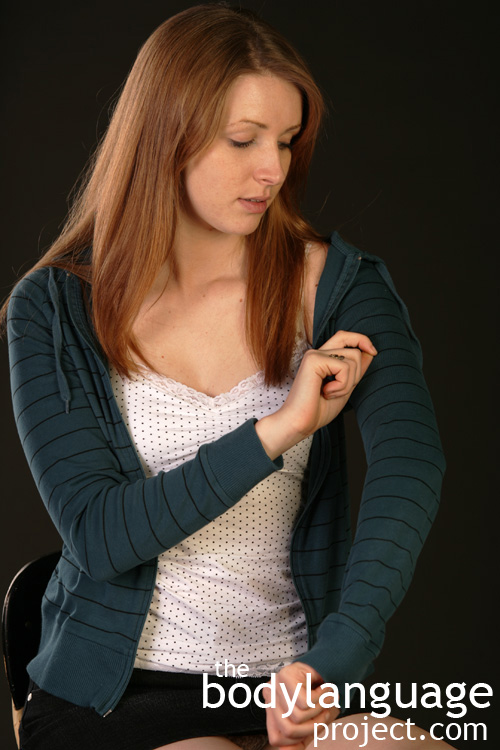Body Language of Invisible Lint Picker or Lint Picker
 Cue: Invisible Lint Picker or Lint Picker
Cue: Invisible Lint Picker or Lint Picker
Synonym(s): Lint Picker (The), Picking Invisible Lint.
Description: When someone in mid-conversation breaks eye contact to remove lint, smooth clothing, apply lipstick and so forth.
In One Sentence: The invisible lint picker is a person who is showing nonverbal distain.
How To Use it: When you wish to send an insult that falls below the conscious radar; pick lint, especially lint that does not actually exist. Removing lint and other self-grooming gestures while listening to another speaks is an obvious insult.
Some moderate grooming in the presence of a date can indicate positive meaning, but should only include things like smoothing and adjusting clothing, fixing the hair, and so forth and not unsightly things like picking the finger nails. A good rule to follow is to avoid breaking eye contact as much as possible while grooming especially when the other person is speaking. This will result in a positive rather than a negative impression.
Context: a) General b) Dating
Verbal Translation: a) b) “I don’t like you and what you are saying so I’m going to act rude and remove fake lint from my body until you shut up.”
Variant: Pimples can be pinched, nose picking, cleaning under the nails, smoothing clothing, applying lipstick, glancing in a mirror. See Eye Aversion, Gaze Avoidance and Wandering Eyes.
Cue In Action: As Debbie was talking she noticed that Mary was much more attentive to her task of removing cat hair from her jacket than she was to her. Debbie got the message loud and clear, broke off the conversation early and carried on with her day.
Meaning and/or Motivation: a) A non-verbal displacement gesture indicating a difference of opinion, disapproval, dislike, contempt, and indifference or dismissiveness which is especially salient when lint is entirely absent indicating that the true purpose is to avoid eye contact. Removing invisible lint shows a critical listener through eye contact avoidance and distraction.
b) In dating, lint picking can sometimes indicate interest through preening to make one appear more attractive, and when done on someone else, is a form of affection. When grooming is a positive signal, it is mostly done in private, thus preparing the self to be viewed. When eye contact is visibly broken, it does however signal disinterest. When lint picking is a negative cue it can be compared to picking the nose, picking the nails or pinching pimples. They all show forms of distasteful grooming that should be done in privacy. Making others witness such grotesqueness is truly offensive and dehumanizing.
Cue Cluster: Lint picking is coupled with eye contact avoidance, overall distraction and a lack of agreement indicators.
Body Language Category: Amplifier, Arrogance or arrogant body language, Courtship display, Indicators of disinterest (IOD), Masked body language.
Resources:
Barroso, Felix ; Feld, Jason. Self-touching and attentional processes: The role of task difficulty, selection stage, and sex differences. Journal of Nonverbal Behavior. 1986. 10(1): 51-64.
Butzen, Nathan David ; Bissonnette, Victor ; Mcbrayer, Dan. Effects of modeling and topic stimulus on self-referent touching. Perceptual and motor skills. 2005. 101(2): 413-20.
Buckley, V., & Semple, S. (2012). Evidence that displacement activities facilitate behavioural transitions in ring-tailed lemurs. Behavioural Processes, 90, 433–435.
Bouhuys, A.L. ; Jansen, C.J. ; van den Hoofdakker, R.H. Analysis of observed behaviors displayed by depressed patients during a clinical interview: relationships between behavioral factors and clinical concepts of activation. Journal of Affective Disorders. 1991. 21(2): 79-88.
Berridge CW,Mitton E, ClarkW, Roth RH. 1999. Engagement in a non-escape (displacement) behavior elicits a selective and lateralized suppression of frontal cortical dopaminergic utilization in stress. Synapse 32:187–197.
Chen, Yi-Chia ; Yeh, Su-Ling. Look into my eyes and I will see you: Unconscious processing of human gaze. Consciousness and Cognition. 2012 21(4): 1703-1710.
Castles, Duncan L. ; Whiten, Andrew ; Aureli, Filippo. Social anxiety, relationships and self-directed behaviour among wild female olive baboons. Animal Behaviour. 1999. 58(6): 1207-1215.
Goldberg, Shelly ; Rosenthal, Robert. Self-touching behavior in the job interview: Antecedents and consequences. Journal of Nonverbal Behavior. 1986. 10(1): 65-80.
Harrigan, Jinni A. Self-touching as an indicator of underlying affect and language processes. Social Science & Medicine. 1985. 20(11): 1161-1168.
Harrigan, Jinni A.; Karen S. Lucic; Denise Kay; Anne McLaney and Robert Rosenthal. Effect of Expresser Role and Type of Self-Touching on Observers’ Perceptions. Journal of Applied Social Psychology. 1991. 21(7): 585-609.
Jenkins, R., Keane, J., & Calder, A.J. (2007, August). From your eyes only: Gaze adaptation from averted eyes and averted heads. Paper presented at the Thirtieth European Conference on Visual Perception, Arezzo, Italy.
Kochanska, G., Coy, K. C., & Murray, K. T. (2001). The development of self-regulation in the first four years of life. Child Development, 72, 1091–1111.
Kochanska, G., Murray, K. T., & Harlan, E. T. (2000). Effortful control in early childhood: Continuity and change, antecedents, and implications for social development. Developmental Psychology, 36, 220–232.
Kirschbaum C, Pirke K-M, Hellhammer DH. 1993. The ‘Trier Social Stress Test’: a tool for investigating psychobiological stress responses in a laboratory setting. Neuropsychobiology 28: 76–81.
Maestripieri D, Schino G, Aureli F, Troisi A. 1992. A modest proposal: displacement activities as an indicator of emotions in primates. Anim Behav 44:967–979.
Mohiyeddini, Changiz ; Semple, Stuart. Displacement behaviour regulates the experience of stress in men. Stress. 2013. 16(2): 163-171.
Mohiyeddini, C., Bauer, S., & Semple, S. (2013a). Displacement behaviour is associated with reduced stress levels among men but not women. PLoS One, 8, e56355.
Mohiyeddini, C., Bauer, S., & Semple, S. (2013b). Public self-consciousness moderates the link between displacement behaviour and experience of stress in women. Stress, 16, 384–392.
Mohiyeddini, C., & Semple, S. (2013). Displacement behaviour regulates the experience of stress in men. Stress, 16, 163–171.
Nelson, Holly ; Geher, Glenn. Mutual Grooming in Human Dyadic Relationships: An Ethological Perspective. Current Psychology. 2007. 26(2): 121-140.
Pecora, Giulia ; Addessi, Elsa ; Schino, Gabriele ; Bellagamba, Francesca. Do displacement activities help preschool children to inhibit a forbidden action? Journal of Experimental Child Psychology. 2014. 126: 80-90.
Pease, Barbara and Allan Pease. 2006. The Definitive Book of Body Language Hardcover. Bantam.
Schino G, Perretta G, Taglioni AM, Monaco V, Troisi A. 1996. Primate displacement activities as an ethopharmacological model of anxiety. Anxiety 2:186–191.
Supplee, Lauren H ; Skuban, Emily Moye ; Shaw, Daniel S ; Prout, Joanna. Emotion regulation strategies and later externalizing behavior among European American and African American children. Development and Psychopathology. 2009. 21(2): 393-415.
Troisi A. 1999. Ethological research in clinical psychiatry: the study of nonverbal behaviour during interviews. Neurosci Biobehav Rev 23:905–913.
Troisi A. 2002. Displacement activities as a behavioral measure of stress in nonhuman primates and human subjects. Stress 5: 47–54.
Thompson, Kristin. Grooming the Naked Ape: Do Perceptions of Disease and Aggression Vulnerability Influence Grooming Behaviour in Humans? A Comparative Ethological Perspective. Current Psychology. 2010. 29(4): 288-296.
Wirth, James H ; Sacco, Donald F ; Hugenberg, Kurt ; Williams, Kipling D. Eye gaze as relational evaluation: averted eye gaze leads to feelings of ostracism and relational devaluation. Personality & social psychology bulletin. 2010 36(7): 869-82.








